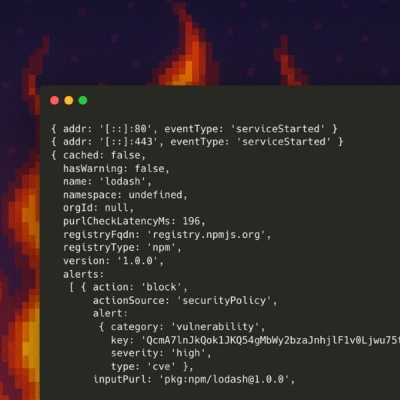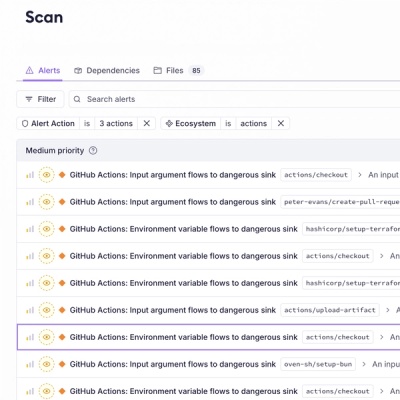
Product
Introducing Socket Firewall Enterprise: Flexible, Configurable Protection for Modern Package Ecosystems
Socket Firewall Enterprise is now available with flexible deployment, configurable policies, and expanded language support.
aws-ssh-tunnel
Advanced tools
aws-ssh-tunnel is a CLI tool used to set up port forwarding sessions with public and private AWS instances that support SSH, such as EC2 and RDS.
This is done by piping stdin and stdout through a secured AWS SSM Session Manager session, removing the need to publicly expose bastion servers.
Supports SSH tunnels with instances in both public and private subnets, including instances that can only be accessed from within a designated VPC or security group.
+-------------------------+
|AWS VPC |
|+-----------------------+|
6. establish ||private subnet || 5. SSH request verified by
tunnel with || +-----+ +-----+ || jump server using public key
remote RDS || | RDS +------| EC2 |------------------------------------+
instance || | | | |------------------------+ |
|| +-----+ +-----+ || 3. Session Manager | |
|+-----------------|-----+| connects to EC2 | |
+------------------|------+ | |
+--------------------+ +-----------------------+
|EC2 Instance Connect| |AWS SSM Session Manager|
+----------|---------+ +-----------------------+
| | |
| 2. establish session | |
1. generate public/private +------+ with SSM Session Manager | |
keypair and send public | USER |-----------------------------+ |
key to jump server using | |-----------------------------------------+
EC2 Instance Connect API +------+ 4. proxy SSH tunnel to AWS SSM session manager
Directly install with pipx or clone locally.
pipx
pipx install aws-ssh-tunnel
git clone
git clone https://github.com/binxio/aws-ssh-tunnel.git
python3 -m pip install .
config
Set up your local config with aws-ssh-tunnel config.
You are prompted to fill in the following details:
aws_region: the aws region in which your instances are located.
aws_profile: the aws profile to use. Should have the necessary IAM permissions to perform ec2-instance-connect:SendSSHPublicKey and ssm:StartSession.
ssh_instance_tag: tag used to identify the (jump) instance that will be used to set up the SSH session. If multiple instances are identified, a random one will be chosen. You can overwrite this variable by passing --tag to the session commands.
Or you can use the following options:
Usage: aws_ssh_tunnel.py config [OPTIONS]
Set AWS configuration.
Options:
-t, --tag TEXT tag (format: KEY=VALUE) of the (jump) instance that will be
used to set up the SSH (tunneling) session. If tunneling to
RDS or other services which only allow internal vpc traffic,
pass the tag of a dedicated jump instance. Omit to use the
tag environment variable in the local configuration file.
[default: (ssh_instance_tag environment variable in aws-ssh-
tunnel.cfg)]
--region TEXT AWS region to use for tunneling session.
--profile TEXT AWS profile to assume for tunneling session.
--help Show this message and exit.
port forwarding
Usage: aws-ssh-tunnel start-forwarding-session [OPTIONS]
Start a port forwarding session.
Example:
aws-ssh-tunnel start-forwarding-session
--remote-host mydb.123456789012.eu-west-1.rds.amazonaws.com
--port 5432
--local-port 5432
--tag application=jump_server
Options:
-t, --tag TEXT tag (format: KEY=VALUE) of the (jump) instance that
will be used to set up the SSH (tunneling) session.
If tunneling to RDS or other services which only
allow internal vpc traffic, pass the tag of a
dedicated jump instance. Omit to use the tag
environment variable in the local configuration
file. [default: (ssh_instance_tag environment
variable in aws-ssh-tunnel.cfg)]
-r, --remote-host TEXT Remote host endpoint to tunnel to. [default:
localhost]
-p, --port TEXT The port on the remote host to forward traffic to.
[default: 22]
-l, --local-port TEXT The port on the local host to route traffic to. If
not provided it takes the value of the remote port.
Provide 0 to choose a random port.
--help Show this message and exit.
ssh session
Usage: aws_ssh_tunnel.py start-ssh-session [OPTIONS]
Start an SSH session on the specified host.
Example:
aws-ssh-tunnel start-ssh-session
-t application=jump_server
Options:
-t, --tag TEXT tag (format: KEY=VALUE) of the (jump) instance that will be
used to set up the SSH (tunneling) session. If tunneling to
RDS or other services which only allow internal vpc traffic,
pass the tag of a dedicated jump instance. Omit to use the
tag environment variable in the local configuration file.
[default: (ssh_instance_tag environment variable in aws-ssh-tunnel.cfg)]
--help Show this message and exit.
FAQs
CLI for port forwarding sessions with private AWS RDS and EC2 instances.
We found that aws-ssh-tunnel demonstrated a healthy version release cadence and project activity because the last version was released less than a year ago. It has 1 open source maintainer collaborating on the project.
Did you know?

Socket for GitHub automatically highlights issues in each pull request and monitors the health of all your open source dependencies. Discover the contents of your packages and block harmful activity before you install or update your dependencies.

Product
Socket Firewall Enterprise is now available with flexible deployment, configurable policies, and expanded language support.

Security News
Open source dashboard CNAPulse tracks CVE Numbering Authorities’ publishing activity, highlighting trends and transparency across the CVE ecosystem.

Product
Detect malware, unsafe data flows, and license issues in GitHub Actions with Socket’s new workflow scanning support.